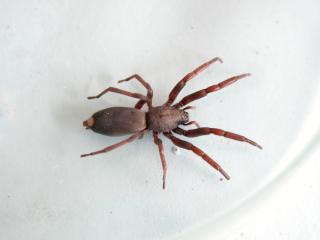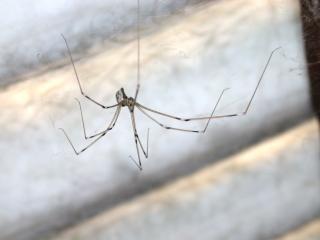White-tailed spiders
White-tailed spiders, Lampona cylindrata, are common and widespread across Australia. They are not web builders but vagrant hunters and are often seen inside houses, especially on summer evenings, wandering in search of prey. They are medium sized spiders, with cylindrical abdomens, grey to black bodies with stout legs and a white patch at the tip of the abdomen. They feed mainly on other spiders, plucking at their webs to imitate the struggling of an ensnared insect and then seizing the unsuspecting spider when it comes out of its retreat.
White-tailed spider bites typically cause initial burning pain followed by swelling and itchiness at the site. Occasionally, weals or cases of blistering ulceration have been reported and some medical studies suggest that this may be due to a secondary infection of the wound. Sensational media reporting of severe cases of skin ulceration (a condition termed ‘necrotic arachnidism’) has given this spider a fearful reputation it probably doesn’t deserve. Recent studies have monitored the medical outcomes of hundreds of verified white-tailed spider bites and found not a single case of ulceration. It is certainly safe to say that necrotic arachnidism is not a common outcome of a white-tailed spider bite. If they are common in the house, it is a good idea to check bedding before going to bed. Also, check your shoes before putting them on and do not leave clothing on the floor, as these spiders are often found sheltering in such situations.
Daddy long-legs
Daddy long-legs, Pholcus phalangioides, are cosmopolitan spiders and are probably the best known spiders world wide. They are almost always associated with human dwellings, famous for their small, dainty bodies with long legs up to 50mm in length.
These spiders are often found in the house or shed with their thin, tangled webs behind doors or attached to ceilings and upper walls in the corners of rooms. The non-sticky web of the daddy long-legs is really just a retreat for the spider and not designed to catch prey. The moment an insect ventures within striking range of the spider it will race out, bite and tangle up its prey until the struggle quickly ceases.
These spiders are harmless but, quite incorrectly, renowned for being deadly poisonous. Although their venom is quite toxic, their tiny fangs are incapable of penetrating human skin and the venom glands hold so little poison that it renders this distinction as merely mythical.


